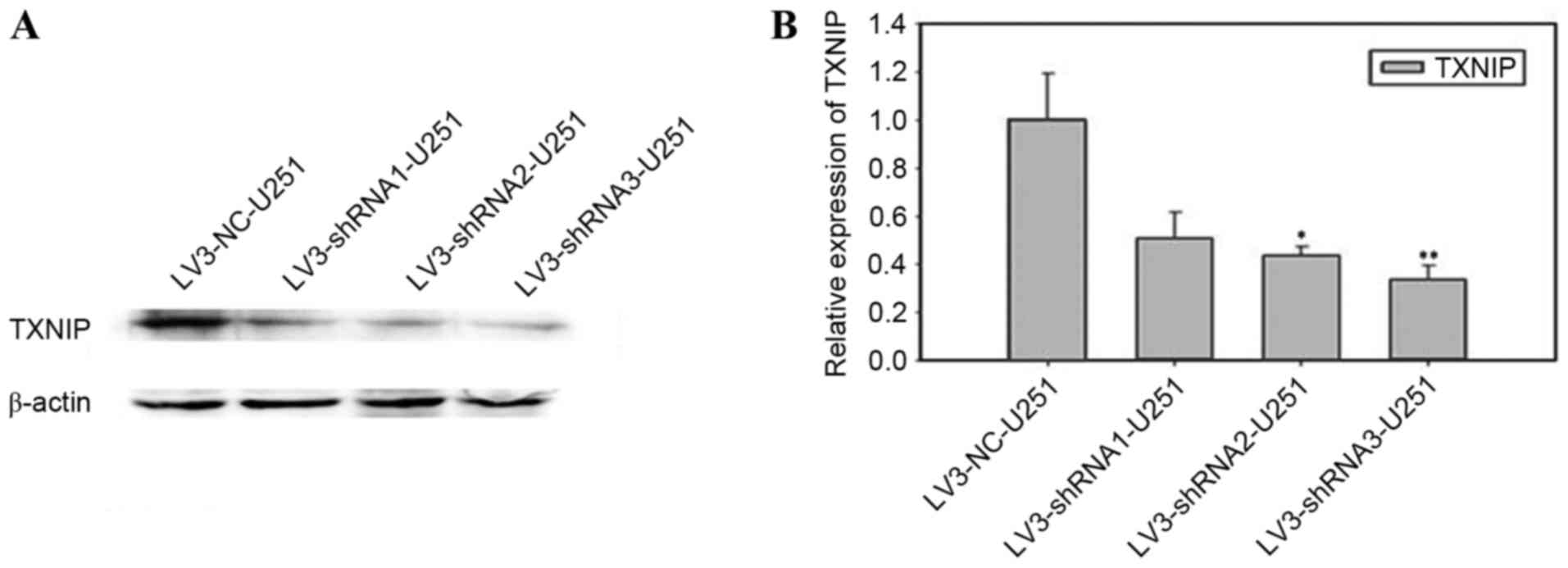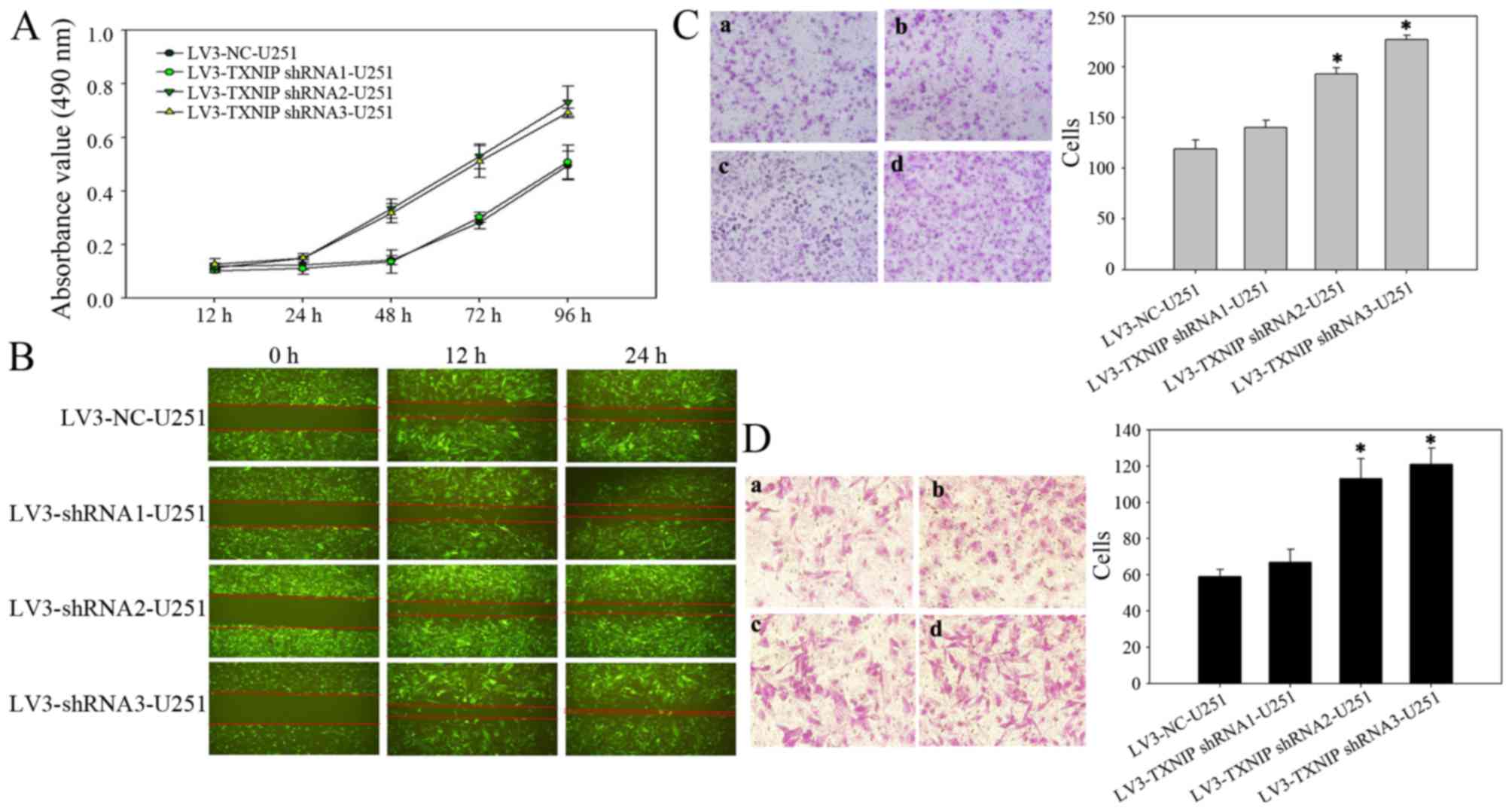|
1
|
Chang L, Su J, Jia XZ and Ren H: Treating
malignant glioma in Chinese patients: Update on temozolomide. Onco
Targets Ther. 7:235–244. 2014.PubMed/NCBI
|
|
2
|
Davis FG and McCarthy BJ: Current
epidemiological trends and surveillance issues in brain tumors.
Expert Rev Anticancer Ther. 1:395–401. 2001. View Article : Google Scholar : PubMed/NCBI
|
|
3
|
Yang P, Wang Y, Peng X, You G, Zhang W,
Yan W, Bao Z, Wang Y, Qiu X and Jiang T: Management and survival
rates in patients with glioma in China (2004–2010): A retrospective
study from a single-institution. J Neurooncol. 113:259–266. 2013.
View Article : Google Scholar : PubMed/NCBI
|
|
4
|
Chen C, Xu T, Lu Y, Chen J and Wu S: The
efficacy of temozolomide for recurrent glioblastoma multiforme. Eur
J Neurol. 20:223–230. 2013. View Article : Google Scholar : PubMed/NCBI
|
|
5
|
Chen KS and DeLuca HF: Isolation and
characterization of a novel cDNA from HL-60 cells treated with 1,
25-dihydroxyvitamin D-3. Biochim Biophys Acta. 1219:26–32. 1994.
View Article : Google Scholar : PubMed/NCBI
|
|
6
|
Kim SY, Suh HW, Chung JW, Yoon SR and Choi
I: Diverse functions of VDUP1 in cell proliferation,
differentiation, and diseases. Cell Mol Immunol. 4:345–351.
2007.PubMed/NCBI
|
|
7
|
Patwari P, Chutkow WA, Cummings K,
Verstraeten VL, Lammerding J, Schreiter ER and Lee RT:
Thioredoxin-inde-pendent regulation of metabolism by the
alpha-arrestin proteins. J Biol Chem. 284:24996–25003. 2009.
View Article : Google Scholar : PubMed/NCBI
|
|
8
|
Zhou J, Yu Q and Chng WJ: Txnip (vdup-1,
tbp-2): A major redox regulator commonly suppressed in cancer by
epigenetic mechanisms. Int J Biochem Cell Biol. 43:1668–1673. 2011.
View Article : Google Scholar : PubMed/NCBI
|
|
9
|
Zhou JB and Chng WJ: Roles of thioredoxin
binding protein (TXNIP) in oxidative stress, apoptosis and cancer.
Mitochondrion. 13:163–169. 2013. View Article : Google Scholar : PubMed/NCBI
|
|
10
|
Yoshihara E, Masaki S, Matsuo Y, Chen Z,
Tian H and Yodoi J: Thioredoxin/Txnip: Redoxisome, as a redox
switch for the pathogenesis of diseases. Front Immunol. 4:5142014.
View Article : Google Scholar : PubMed/NCBI
|
|
11
|
Louis DN, Ohgaki H, Wiestler OD, Cavenee
WK, Burger PC, Jouvet A, Scheithauer BW and Kleihues P: The 2007
WHO classification of tumours of the central nervous system. Acta
Neuropathol. 114:97–109. 2007. View Article : Google Scholar : PubMed/NCBI
|
|
12
|
Livak KJ and Schmittgen TD: Analysis of
relative gene expression data using real-time quantitative PCR and
the 2(−Delta Delta C(T)) method. Methods. 25:402–408. 2001.
View Article : Google Scholar : PubMed/NCBI
|
|
13
|
Zhou J, Bi C, Cheong LL, Mahara S, Liu SC,
Tay KG, Koh TL, Yu Q and Chng WJ: The histone methyltransferase
inhibitor, DZNep, up-regulates TXNIP, increases ROS production, and
targets leukemia cells in AML. Blood. 118:2830–2839. 2011.
View Article : Google Scholar : PubMed/NCBI
|
|
14
|
Butler LM, Zhou X, Xu WS, Scher HI,
Rifkind RA, Marks PA and Richon VM: The histone deacetylase
inhibitor SAHA arrests cancer cell growth, up-regulates
thioredoxin-binding protein-2, and down-regulates thioredoxin. Proc
Natl Acad Sci. 99:pp. 11700–11705. 2002; View Article : Google Scholar : PubMed/NCBI
|
|
15
|
Yamaguchi F, Takata M, Kamitori K, Nonaka
M, Dong Y, Sui L and Tokuda M: Rare sugar d-allose induces specific
up-regulation of txnip and subsequent G1 cell cycle arrest in
hepatocellular carcinoma cells by stabilization of p27kip1. Int J
Oncol. 32:377–385. 2008.PubMed/NCBI
|
|
16
|
Song H, Cho D, Jeon JH, Han SH, Hur DY,
Kim YS and Choi I: Vitamin d (3) up-regulating protein 1 (vdup1)
antisense DNA regulates tumorigenicity and melanogenesis of murine
melanoma cells via regulating the expression of fas ligand and
reactive oxygen species. Immunol Lett. 86:235–247. 2003. View Article : Google Scholar : PubMed/NCBI
|
|
17
|
Ying Z, Li Y, Wu J, Zhu X, Yang Y, Tian H,
Li W, Hu B, Cheng SY and Li M: Loss of miR-204 expression enhances
glioma migration and stem cell-like phenotype. Cancer Res.
73:990–999. 2013. View Article : Google Scholar : PubMed/NCBI
|
|
18
|
Zhang P, Pang X and Tu Y:
Thioredoxin-interacting protein as a common regulation target for
multiple drugs in clinical therapy/application. Cancer Transl Med.
1:26–30. 2015. View Article : Google Scholar
|
|
19
|
Han SH, Jeon JH, Ju HR, Jung U, Kim KY,
Yoo HS, Lee YH, Song KS, Hwang HM, Na YS, et al: VDUP1 upregulated
by TGF-beta1 and 1,25-dihydorxyvitamin D3 inhibits tumor cell
growth by blocking cell-cycle progression. Oncogene. 22:4035–4046.
2003. View Article : Google Scholar : PubMed/NCBI
|
|
20
|
Le Jan S, Le Meur N, Cazes A, Philippe J,
Le Cunff M, Léger J, Corvol P and Germain S: Characterization of
the expression of the hypoxia-induced genes neuritin, txnip and
IGFBP3 in cancer. FEBS Lett. 580:3395–3400. 2006. View Article : Google Scholar : PubMed/NCBI
|
|
21
|
Lee KN, Kang HS, Jeon JH, Kim EM, Yoon SR,
Song H, Lyu CY, Piao ZH, Kim SU, Han YH, et al: Vdup1 is required
for the development of natural killer cells. Immunity. 22:195–208.
2005. View Article : Google Scholar : PubMed/NCBI
|
|
22
|
Erkeland SJ, Palande KK, Valkhof M, Gits
J, Danen-van Oorschot A and Touw IP: The gene encoding
thioredoxin-interacting protein (TXNIP) is a frequent integration
site in virus-induced mouse leukemia and is overexpressed in a
subset of AML patients. Leuk Res. 33:1367–1371. 2009. View Article : Google Scholar : PubMed/NCBI
|
|
23
|
Dutta KK, Nishinaka Y, Masutani H,
Akatsuka S, Aung TT, Shirase T, Lee WH, Yamada Y, Hiai H, Yodoi J
and Toyokuni S: Two distinct mechanisms for loss of
thioredoxin-binding protein-2 in oxidative stress-induced renal
carcinogenesis. Lab Invest. 85:798–807. 2005. View Article : Google Scholar : PubMed/NCBI
|
|
24
|
Ahsan MK, Masutani H, Yamaguchi Y, Kim YC,
Nosaka K, Matsuoka M, Nishinaka Y, Maeda M and Yodoi J: Loss of
interleukin-2-dependency in HTLV-I-infected T cells on gene
silencing of thioredoxin-binding protein-2. Oncogene. 25:2181–2191.
2006. View Article : Google Scholar : PubMed/NCBI
|
|
25
|
Cheng YD, Geng H, Cheng SH, Liang P, Bai
Y, Li J, Srivastava G, Ng MH, Fukagawa T, Wu X, et al: The KRAB
Zinc finger protein ZNF382 is a general, proapoptotic tumor
suppressor repressing multiple oncogenes and frequently silenced in
multiple carcinomas. Cancer Res. 70:6516–6526. 2010. View Article : Google Scholar : PubMed/NCBI
|
|
26
|
Cheng YD, Liang P, Geng H, Wang Z, Li L,
Cheng SH, Ying J, Su X, Ng KM, Ng MH, et al: A novel 19q13
nucleolar zinc finger protein suppresses tumor cell growth through
inhibiting ribosome biogenesis and inducing apoptosis but is
frequently silenced in multiple carcinomas. Mol Cancer Res.
10:925–936. 2012. View Article : Google Scholar : PubMed/NCBI
|
|
27
|
Wang S, Cheng Y, Du W, Lu L, Zhou L, Wang
H, Kang W, Li X, Tao Q, Sung J and Yu J: Zinc-finger protein 545 is
a novel tumour suppressor that acts by inhibiting ribosomal RNA
transcription in gastric cancer. Gut. 62:833–841. 2013. View Article : Google Scholar : PubMed/NCBI
|
|
28
|
Kato T, Shimono Y, Hasegawa M, Jijiwa M,
Enomoto A, Asai N, Murakumo Y and Takahashi M: Characterization of
the HDAC1 complex that regulates the sensitivity of cancer cells to
oxidative stress. Cancer Res. 69:3597–3604. 2009. View Article : Google Scholar : PubMed/NCBI
|
|
29
|
Ungerstedt JS, Sowa Y, Xu WS, Shao Y,
Dokmanovic M, Perez G, Ngo L, Holmgren A, Jiang X and Marks PA:
Role of thioredoxin in the response of normal and transformed cells
to histone deacetylase inhibitors. Proc Natl Acad Sci USA. 102:pp.
673–678. 2005; View Article : Google Scholar : PubMed/NCBI
|
|
30
|
Yan GR, Xu SH, Tan ZL, Liu L and He QY:
Global identification of miR-373-regulated genes in breast cancer
by quantitative proteomics. Proteomics. 11:912–920. 2011.
View Article : Google Scholar : PubMed/NCBI
|

















